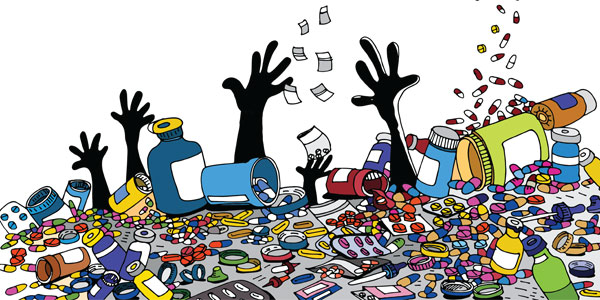Antibiotics: Too much of a good thing?
- Deryn Graham
The complicated doctor-patient dynamic requires managing expectations to protect both drug efficacy and public health.

If your doctor prescribes a broad-spectrum antibiotic for your bacterial infection, there’s a good chance that it will hit the mark and make you feel better within a matter of days. Or not. It’s more likely you had a viral infection – a common cold, for example – and your body would rid itself of the virus. Antibiotic medication is just the doctor’s way of pacifying you.
We have a complex relationship with our doctors in South Africa. At the affluent end of the market, our medical aid pays in part or in full for both a consultation and the prescription with which you leave the doctor’s rooms, so the pain we feel is not necessarily financial.
At the other end of the scale of the doctor/patient relationship in South Africa is the person who lives far from any primary healthcare facility, takes public transport to a clinic, and stands (or sits, if they’re lucky) in a queue for many hours before they finally get to see a doctor. After going through all this, on top of feeling ill, they probably have as high an expectation of receiving treatment in the form of drugs as does the private patient – and so the doctor dispenses an antibiotic.
Doctor anticipation, patient expectation
Lenore Manderson, Distinguished Professor of Public Health and Medical Anthropology in the Wits School of Public Health contends that this is not a medical strategy to cure the patient but to keep their life on track. “Getting sick adds to the many insurmountable socioeconomic challenges that poor South Africans face every day,” she says.
According to Dr Duane Blaauw, Senior Researcher in the Wits Centre for Health Policy, surveys show that patients assume that doctors who prescribe medication are more qualified and more knowledgeable than those who send you away with instructions to rest and drink lots of fluids. And the more medication these doctors prescribe, the more their stock rises with patients.
As far as our belief in the medical profession goes, ironically, the doctor who spends a little more time with the patient to explain the difference between a viral and a bacterial infection, and which treatment goes with what, is more knowledgeable (though of course not necessarily more qualified) than the one who dispenses somewhat injudiciously.
“It’s the tension between patient expectation and doctor anticipation of that expectation, which results in many cases of over prescribing,” says Blaauw. “For example, when a doctor sees a child and is faced with parental anxiety, they may write a script, even if it’s unnecessary.”
The consequences of over-prescribing medication – that is, prescribing without any medical evidence that a drug treats the symptoms or cause of infection – is that drugs become ineffective. They are rendered antimicrobial resistant.
Antimicrobial resistance
Muhammed Vally is a Lecturer in Clinical Pharmacy at Wits. He says that overcrowding and poor infection control in hospitals exacerbate the spread of infection. When the first, second, and third lines of attack against infection – via antibiotics – have been knocked out due to overuse, patients may be left vulnerable from virulent infections that do not respond to available drugs. That’s when we start to see deaths because of antimicrobial resistance.
“If doctors tested for certain conditions, they would find that antibiotics are not required, but they don’t send samples to labs because of costs and the risk of overburdening the system. However, the flip side of that is that prescribing antibiotics unnecessarily is also costly to the public health system,” says Vally.
The World Health Organization (WHO) defines antimicrobial resistance (AMR) as occurring when bacteria, viruses, fungi, and parasites change over time and no longer respond to medicines, making infections harder to treat and increasing the risk of disease spread, severe illness and death.?
As a result of drug resistance, antibiotics and other antimicrobial medicines become ineffective and?infections become increasingly difficult or impossible to treat.
The WHO has declared AMR one of the top 10 global public health threats facing humanity.
Manderson says, “Pathogens are always mutating and therefore different variants of a virus, bacteria, or fungus become resistant to certain drugs. We need to protect our drugs against overuse, because before long there will be nothing left in the doctors’ arsenal with which to treat genuine cases.”
‘Antibiotic guardians’
It’s all about the judicious use of antibiotics. For some infections, an antibiotic is absolutely the right thing to prevent complications. Manderson cites the prevalence of untreated urinary tract infections (UTIs), especially in the elderly, as an example. If the elderly lose their capacity to respond to antibiotics, UTIs can lead to much more serious symptoms, and then there is nothing left with which to treat the UTI,” she says.
The Federation of Infectious Diseases Societies of Southern Africa supports the South African Antimicrobial Stewardship programme.
A collaboration between the Department of Health and the Department of Agriculture, Forestry and Fisheries, the programme invites both human and animal healthcare professionals to pledge to become ‘antibiotic guardians’ committed to improving antibiotic prescription, to protecting patients from harm caused by unnecessary antibiotic use, and to combat antibiotic resistance.
- Deryn Graham is a freelance writer.
- This article first appeared in?Curiosity,?a research magazine produced by?Wits Communications?and the?Research Office.
- Read more in the 16th issue, themed: #Drugs, where we highlight the diversity, scope, and multi-dimensional nature of drug-related research at Wits University.
